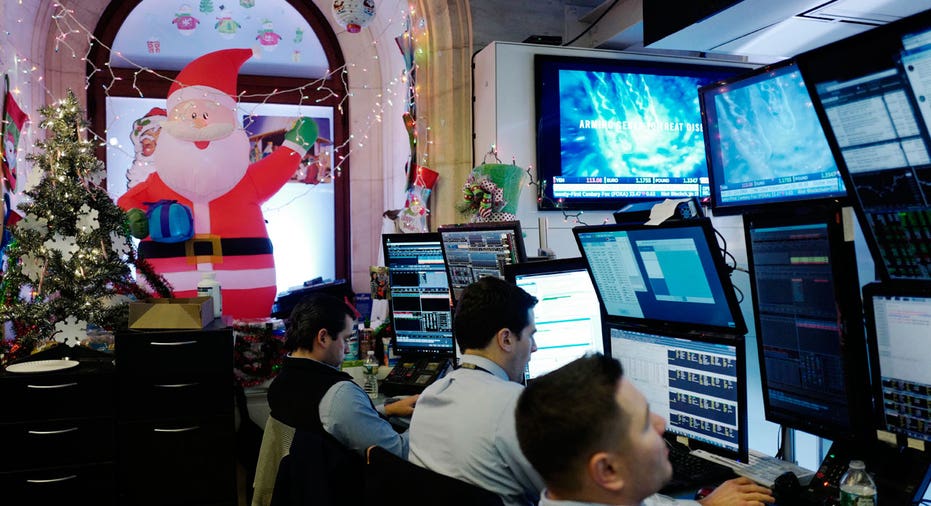Will a 'Santa rally' give a robust stock market an added lift?

Stocks in midst of strongest 7-day period since 1950
Expecting a "Santa Claus" stock market rally in a year which has already provided a 20% gain feels just a little greedy.
Yet, that's still the most likely outcome, analysts said, though it's never guaranteed.
Also known as the "December Effect", the Santa rally refers to the market's tendency to rise in the last five trading days of the year and the first two days of the new year. That means it officially began Friday on a rather indifferent note.
According to Ryan Detrick, senior market strategist at LPL Financial, the Santa Claus rally is the second strongest seven-day period of the year going back to 1950.
"The days during the Santa Claus Rally have gained 1.35% on average, with only one other seven-day period of the entire year sporting a better return. Not to be outdone, the 7 days of Santa have been higher 77.6% of the time, making it the 7 days of the year that are most likely to be higher," Detrick said in a note.
The S&P 500 closed virtually unchanged at 2,683.34 on Friday and is up 20% year to date. The historical average return for the S&P 500 is about 8%. Dow industrials are up 25%, while the Nasdaq Composite is up an impressive 29%.
Growth stocks--shares of companies expected to grow earnings and revenues faster than their peers--have returned twice as much as value stocks--shares viewed as undervalued relative to fundamentals--this year, with the S&P 500 growth index rising 26%, while value index gaining 13%.
Of the S&P 500's 11 main sectors, six are up double digits, and only two sectors--energy and telecoms--are down for the year.
A gain of 1.35% for the S&P 500, would take the index to fresh record highs. So far this year, the benchmark index closed at a record 62 times, according to FactSet.
It's not just the end of December--the entire month is usually the strongest of the year. Some view the holiday season--a period after Thanksgiving and the New Year's Day as conducive to stock market gains.
And the momentum behind the market's run has been so strong that few see it ending any time soon.
Do investors "really want to step in front of this freight train, or, if you will, this gift-laden sleigh, and say the rally is over? We could get run over by Santa and his reindeer," wrote Scott Wren, senior global equity strategist at Wells Fargo Investment Institute.
"We certainly do not believe the cycle is over, and tax reform looks like it could extend the good times for a couple more years, " Wren said.
From a fundamental point of view, prices seem justified due to earnings growth and a sound favorable economic background. Add to that the passage of the tax-cut deal that is going to lower corporate tax rates, it is not hard to imagine that the market can continue to climb.
President Donald Trump signed the tax-cut legislation into law on Friday. It permanently lowers the corporate tax rate to 21% from 35%. Tax rates for individuals also fell, but the cuts are temporary and are expected to fall mostly to the wealthy, according to an analysis by the Tax Policy Center.
From a technical perspective, stocks are likely climb further for a few more weeks, according to Katie Stockton, chief technical strategist at BTIG.
"There are no major signs of upside exhaustion on the last push higher in the S&P 500, and seasonal influences are favorable through next week," Stockton said, in a note.
"Our market internal measures remain conducive to upside follow-through, such that the next significant pullback is more likely to be launched in mid-January," Stockton said.
Barring some major unexpected events, there is little that may derail the Santa rally, according to JJ Kinahan, chief strategist at TD Ameritrade.
"Normal selling pressure will wait until 2018 when investors return from their holidays and will start sorting companies into those that will benefit from the tax legislation and the ones that won't. Sector rotation appears delayed until then," he said.
Investors can expect trading volumes to drop sharply in the holiday-shortened week next week with a lot of traders taking time off until January.
European markets will also be closed on Dec. 26.
The U.S. economic calendar is light, with jobless claims and international trade data, both due Thursday, among the few highlights.